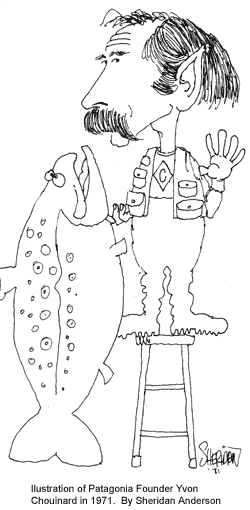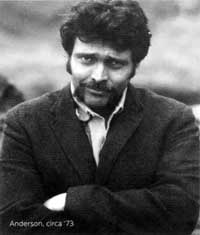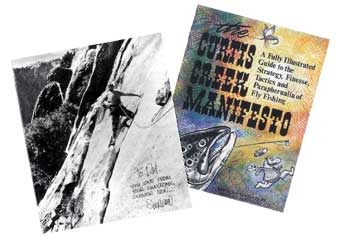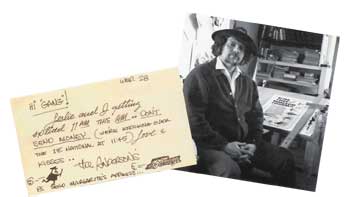Sheridan Anderson: Master of the Manifesto
 FROM THE TOP BUNK of a bed, in the half-darkness of a tiny childhood nightlight, Sheridan Anderson hears his little brother, Mike, whisper up to him, “Tell me a story.” There’s an easel in the shadows. “Sherry” starts talking from an imagination somehow wider than the boundaries of a ten-year-old mind, spinning tales about characters from his daytime doodles. That his dominant protagonist is a balloon called The Creep doesn’t matter—what matters is that the imagination and the doodles formed the genesis for the greatest instructional fly-fishing book of all time.
FROM THE TOP BUNK of a bed, in the half-darkness of a tiny childhood nightlight, Sheridan Anderson hears his little brother, Mike, whisper up to him, “Tell me a story.” There’s an easel in the shadows. “Sherry” starts talking from an imagination somehow wider than the boundaries of a ten-year-old mind, spinning tales about characters from his daytime doodles. That his dominant protagonist is a balloon called The Creep doesn’t matter—what matters is that the imagination and the doodles formed the genesis for the greatest instructional fly-fishing book of all time.
Browse the fishing section of any chain bookstore and there are enough how-to titles to fill an entire shelf. There’s The Everything Fishing Book, Fly Fishing for Dummies, The Complete Idiot’s Guide to Fly Fishing, Fly Fishing Made Easy. There’s The Essential Guide to Fly-Fishing, The Simple Art of Fly-Fishing, and The Ultimate Book of Fly-Fishing. But none have endured—and been cherished—like Sheridan Anderson’s Curtis Creek Manifesto. Almost every fly fisherman has it, knows it, or has recommended it. Its humor, illustrations, and touches of randomness are unique in the literature of the sport. If a fishing book sells a couple thousand copies, it’s considered a success. The Manifesto has sold a quarter of a million.
And it was clear, from very early on, that Anderson could pull it off. Even as a kid, he was passionate and creative and curious. Brother Mike, three years younger, was into practically everything but fishing: hiking, biking, baseball, football. “My side of the room was always straightened up, neat as a pin,” Mike recalls. Sheridan’s side was littered with Sports Afield and Outdoor Life, oil paintings, drawings, books on the local flora and fauna. He drew cartoons for the school paper and wrote for the school yearbook. “He had his vise over there and he tied flies, and he had his creel and some other damn things,” Mike says. As Sheridan once countered, “Mike was a fastidious little bastard….When he wasn’t outside fielding grounders he could usually be found lying on his bed staring with big calf-eyes at Yvonne DeCarlo or seated thereon rubbing some kind of mysterious goo into his baseball mitt.”
Despite all his book and magazine research, Sheridan long felt he was an inferior angler. “I am, at best, a poor fly fisherman,” he once wrote. “I wanted to be a master streamsmith with a dry fly. The Lord of the Rivulets. The Scourge of the Firehole.” His uncle, Grant Wooton, was his inspiration, a man who could “see through water as tho [sic] he had sonar, and no one, no one, in over sixty years of fishing, ever beat him.” With Uncle Grant and Grant’s son, Jay, the teenage Sheridan fished his way across the Yellowstone Plateau: The Firehole, the Madison, the Gallatin, Grayling Creek, Duck Creek, Cougar Creek.
 And when he couldn’t travel so far out of Utah, he still managed to head into the nearby mountains and find the inspiration for his future book: Curtis Creek, on the north fork of Utah’s Blacksmith’s Fork River. It was tough water, fair water, but “definitely not a pussy stream.”
And when he couldn’t travel so far out of Utah, he still managed to head into the nearby mountains and find the inspiration for his future book: Curtis Creek, on the north fork of Utah’s Blacksmith’s Fork River. It was tough water, fair water, but “definitely not a pussy stream.”
Anderson was born on September 18, 1936, in the Los Angeles area, and his father—after a stint in the Army— became a car salesman and moved the Anderson clan, four strong, to Salt Lake City. “My parents were never like Ozzie and Harriet,” Mike says. “It wasn’t really dysfunctional…well, I guess it kind of was.” Their parents got into frequent spats, fueled by the alcohol that was a part of family life from the beginning. Their relationship was consistently rocky, but they managed to stay together—in honor of the now-tired phrase “for the kids.” Recalls Mike, “It was hard to keep the boat going in one direction.”
When Mike was a junior in high school, he moved to L.A., but Sheridan stayed in the dry Utah climate, having suffered from asthma since early childhood. He studied art at the University of Utah but never finished, and took a few courses at colleges around the West. In his early 20’s, always migrating from one place to the next, he met climbers whom he eventually followed to Yosemite, and the rockcraft epicenter at Camp 4—men like Yvon Chouinard, Royal Robbins, Chuck Pratt, Steve Roper, Roger Keckeissen, and Joe Kelsey. Sheridan was never a climber of their caliber, but he was part of their climbing fraternity for nearly two decades.
In the late 1960s, Camp 4 was full of unruly pioneers, lithe superclimbers who spent their days forging new ascents and their nights partying under the yellow pines. “We shoplifted to feed ourselves,” says Roger Keckeissen, now a flyfishing guide in Livingston, Montana. “We’d hang out in the cafeteria and get coffee, and when the tourists left, we’d finish off their leftover toast and bacon.” They hung out on Sentinal Beach, on the Merced, long-haired and naked, tanned and stoned. While the climbers were scouting routes on El Cap’s Salathe Wall, on Half Dome, on Sentinal, Sheridan would fish, drink, and draw. As Kelsey wrote in The Climbing Cartoons of Sheridan Anderson, published after Sheridan’s death, “Unflattering caricature was one more obstacle at the end of an arduous epic, but…a returning Rock God could drink beer with Sheridan and be himself.” Once, when Chouinard was out climbing a big wall, Sheridan painted his ubiquitous van. “At one Camp 4 party, Chuck Pratt was too drunk to stand up, and he passed out on the ground curled up with my golden retriever,” says Kelsey. “The party went on around him, and Sheridan grabbed his pad and sketched them. The caption was, ‘I knew there’d be someone at this party I could talk to.’”
But there was not a hint of sadism in him; he liked to tease, but he was never mean-spirited. There was a certain gentleness behind his earthy humor and roguish impression. He was never shy about poking fun at the self-serious athletes in Camp 4, never afraid to pick up on the foible of a starchy, serious climber and make light of it. Royal Robbins was often the butt of Sheridan’s doodles, represented as a shining Superman or wearing his trademark glasses and English driving cap. Robbins wrote in a tribute to Sheridan: “He was one of the chief chroniclers of the vanities and pretensions of many stars of that period. Sheridan had a double talent: the ability to read character, and the skill to render it with precise, satirical strokes.” Some of his cartoons were obscene, some were touching, but all were spot-on. If anyone—climber, fisherman, friend—took himself too seriously, he was open fodder.
 Sheridan was a man who made strong first impressions. (What other fisherman shows up with rod, reel, creel, and cape?) Kelsey first met him at breakfast in Yosemite in 1968 to talk about publishing a climbing rag that eventually became The Vulgarian Digest. (The name was chosen, in part, for the initials.) “I’d seen his cartoons, and I figured he was just a cynical artist, some wiry chain smoker with beady eyes,” Kelsey says. “But I was way off. He was big and round and had a laugh you could hear all over the lodge. When I first met him he was wearing a white t-shirt, brown, paint-spattered slacks, suspenders, and shoes that looked like he’d stolen them from a wino.” Sheridan promptly appointed himself artistic director of the V.D., but insisted that he draw under the nom-de-plume E. Lovejoy Wolfinger III so that his publishers at Summit, another climbing journal, wouldn’t know. “From the very beginning, he was wildly outgoing,” Kelsey says.
Sheridan was a man who made strong first impressions. (What other fisherman shows up with rod, reel, creel, and cape?) Kelsey first met him at breakfast in Yosemite in 1968 to talk about publishing a climbing rag that eventually became The Vulgarian Digest. (The name was chosen, in part, for the initials.) “I’d seen his cartoons, and I figured he was just a cynical artist, some wiry chain smoker with beady eyes,” Kelsey says. “But I was way off. He was big and round and had a laugh you could hear all over the lodge. When I first met him he was wearing a white t-shirt, brown, paint-spattered slacks, suspenders, and shoes that looked like he’d stolen them from a wino.” Sheridan promptly appointed himself artistic director of the V.D., but insisted that he draw under the nom-de-plume E. Lovejoy Wolfinger III so that his publishers at Summit, another climbing journal, wouldn’t know. “From the very beginning, he was wildly outgoing,” Kelsey says.
And perpetually artistic. He drew for Ascent, Mountain, and Mountain Gazette, coming up with characters like Sir Jack Long-Gland, Lord Bonehead, Hamish McPiton and the dreaded snake, Bullshitmaster. The idea for the Curtis Creek Manifesto first took root when Sheridan was living at Camp 4, climbing and, as he wrote, “supplying a half-dozen fellow pirates with fresh trout.” He continues, “Lazing over Red Mountain Burgandy [sic] and sloe-eyed maids by the crystalline pools of the Merced, I was often admonished to harness my expertise for posterity in order to maintain my unorthodoxy in a more lavish manner.”
While he spent summers in Yosemite, he wintered in Reno, in Bishop, in San Francisco. “He was very much of the San Francisco crowd, “ says Frank Amato, the eventual publisher of the Manifesto. “He really captured the mindset of that time and place.” When then-fledgling photographer Ed Cooper was looking for a place to rent in 1967, as the Summer of Love was peaking into pot and bellbottoms and beads, he moved in with Sheridan. It was a random union, but the pair got along and soon moved into a bigger apartment near Golden Gate Park in the Richmond District. Dubbed the 6th Avenue Delicatessen and Commune, there was enough room for darkrooms, easels, and girlfriends. “When I lived with him, I had a girlfriend—now my wife—and he married a woman named Leslie Fairbairn, but he’d already been married before—to another Lesley (this one with an l-e-y ending) who had two kids,” Cooper says. “I think his attitude toward women was kind of archaic.” Neither matrimony lasted more than a year or two, perhaps because Sheridan claimed that “marriage was an admission of failure.”
Cooper fondly remembers Sheridan’s incredible talent, but also how heavily Sheridan was hitting the bottle, and how he once admitted to him, “From the first drink I ever had, I knew this was what I wanted to do.” Sheridan seemed to need the prod of liquor—three parts water, one part whiskey—to get creative juices flowing, and once wrote, “Frequently in the execution of his artistic and literary pursuits, Mr. Anderson is wont to employ spirits to prime and sustain his muse…Historians believe that a similar formula was used to render the ancient Celts fearless in battle.” When Cooper moved to Mendocino with his new bride, Sheridan and Leslie came to visit; Sheridan promptly drank all the booze in the house, left in his pick-up, and stayed out most of the night. The “final binge,” as Cooper put it, was a little too much, and he lost touch soon after.
During one of his Bay Area stints, Sheridan finally started drawing The Curtis Creek Manifesto while making a small amount of money by painting signs for city businesses. It was a process. Sheridan later joked, “It took me three seasons to dope out the teaching methods, employing live guinea pigs, all of whom knew nothing and who now catch fish.” In 1976, Joe Kelsey lived with him in a tiny, pie slice–shaped apartment on Potrero Hill. “It was a mess,” he says. “And Sheridan would go in these diets—one bowl of oatmeal a day for a week. On the eighth day, I’d come home and he’d be shit-faced, and we’d go get a huge Mexican dinner in the Mission.” His work patterns followed in much the same way: Sometimes Kelsey would come home from his editing job in Berkeley and Sheridan would have big drawings hung on the walls. And sometimes… nothing. “I tried to help him, but fishing wasn’t my thing,” says Kelsey. “I know he was out talking to people at the Golden Gate Park casting ponds and wandering around fly shops.”
One of those shops, just off 3rd and Market, happened to be where Glenn Brackett was working for Winston Fly Rods—and one day Sheridan just walked in and wanted feedback on his cartoon concept. “He looked like he’d just fallen out of the gutter,” Brackett says. “And that never changed. He always seemed a bit ragged.” What started as a short conversation turned into a close, yearlong relationship, spiked with Sheridan’s productive spells and sporadic vanishings, filled with talk of tackle and rivers and philosophy. “He’d bring in his galleys and idea sheets and pieces, and we’d review it with him,” Brackett says. “He is the character in that book, although it goes unnamed.” When Winston moved to Twin Bridges, Montana in 1976, the two lost touch.
After finishing about 15 pages of The Curtis Creek Manifesto, Anderson sent them—and his vision—up to Frank Amato in Milwaukie, Oregon. “He looked like the perfect ringer for Long John Silver,” says Amato. “He was this big guy and he sort of talked with a growl.” Amato liked what he saw and The Curtis Creek Manifesto, published in 1978, turned out to be a cult classic, a requisite primer, and one of the publisher’s top five sellers—out of 300-odd titles. “Other than Isaak Walton, he’s probably the single American who got more people fishing than anyone else,” Amato says.
 By the time the book was released, Sheridan was in his early 40’s; he kept moving, kept drinking, kept doodling and writing for various outdoor mags. Every so often, he’d head into the mountains for days at a time to backpack and fish—when it was time to “belabor my 235 pounds of pickled blubber out beyond the road heads, far beyond the siren call of Crisco beer stubs and sybaritic deadfalls.” His asthma kept worsening, so he split time between his grandmother’s home in Las Vegas and a cabin on the Williamson River in Chiloquin, Oregon (which he shared for a while with legendary Oregon fly tier Polly Rosborough, author of the seminal 1965 book, Tying and Fishing the Fuzzy Nymph).
By the time the book was released, Sheridan was in his early 40’s; he kept moving, kept drinking, kept doodling and writing for various outdoor mags. Every so often, he’d head into the mountains for days at a time to backpack and fish—when it was time to “belabor my 235 pounds of pickled blubber out beyond the road heads, far beyond the siren call of Crisco beer stubs and sybaritic deadfalls.” His asthma kept worsening, so he split time between his grandmother’s home in Las Vegas and a cabin on the Williamson River in Chiloquin, Oregon (which he shared for a while with legendary Oregon fly tier Polly Rosborough, author of the seminal 1965 book, Tying and Fishing the Fuzzy Nymph).
All this time, and, in fact, all his life, he stayed in sporadic touch with friends and family in letters and postcards with (sometimes) random flair and (sometimes) plain lewdness. His buddy Joe Kelsey received a postcard addressed to “Captain K and His Traveling Circus and Canine Hit Squad.” His brother, Mike, received a wedding announcement—on a postcard—that read, “Leslie and I are getting spliced at 11 A.M. this A.M. … Don’t send money (we’re knocking over the 1st National at 11:45).”
“I’m sure they went all the way through the postal system with every postal employee saying to themselves, ‘what in the hell is in this thing?’” says Amato. Sometimes he wrote about conspiracies that held not a shred of truth; sometimes, he sketched naked women crawling with their fly rods; sometimes, he simply took artistic liberties with Goofy and Mickey.
Just like everyone can remember the first time they met Sheridan, almost everyone can remember the last time they saw him. Joe Kelsey, who was on his way from Berkeley to the canyons of southwest Utah, stopped by to visit Sheridan in Vegas in 1981. “By then, there were all these hot climbers sleeping in their VW buses near Red Rocks,” he says. “They were drinking Perrier and doing yoga. Sheridan came in with a bottle of Jack, and plunked down in a chair, and they were all in awe of him. They knew he was one of the greats.” One of the last times Mike Anderson saw him was at their father’s funeral in February 1983; Sheridan was close to 300 pounds, and didn’t look well. “I hadn’t heard from him in a while, other than that drunken phone call every so often: ‘I miss you, I love you, brother,’” says Mike. “He just didn’t take good care of himself.”
On the evening of March 31, 1984, while he was in Vegas, he suffered an acute attack of emphysema and passed away. Mike spread his ashes in the Golden Trout Wilderness near Lone Pine, where Sheridan had spent many seasons exploring the streams and high mountain lakes of the southern Sierra. It was a place he’d hiked before, where he had found peace and solitude—and even found the elusive golden trout, “a leaping, flashing, dancing, bold ray of living sunlight.” He wrote:
Mount Humphreys was blazing away in the late afternoon sun, looking like a colossal throne against the relentless blue sky. I grinned and started laughing. I’m an eagle (I thought), a big, fat, very thirsty, rollicking eagle who was about to spread his wings and swoop down to Bishop and drink gallons and gallons of cold beer.











